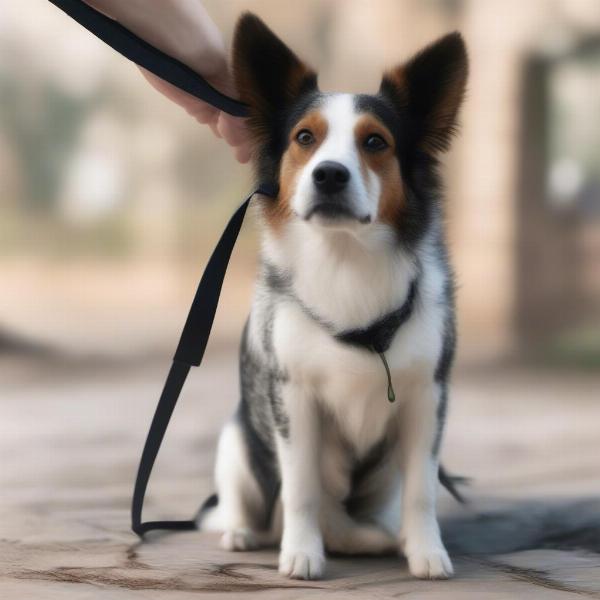A slip lead leash, also known as a slip collar or slip leash, is a single loop of material, often rope or nylon, that acts as both collar and leash. It tightens when the dog pulls and loosens when they walk politely, offering a quick and effective way to control your canine companion. While versatile, understanding proper usage and the potential pros and cons of a slip lead is crucial for responsible dog ownership.
How Does a Slip Lead Work?
The slip lead works by creating a loop around the dog’s neck. When your dog pulls, the loop tightens, applying pressure. This pressure discourages pulling. When the leash is slack, the loop loosens, releasing the pressure. It’s this dynamic tightening and loosening action that makes the slip lead a popular tool for training and handling dogs.
Advantages of Using a Slip Lead for Dogs
Slip leads offer several advantages, particularly for training and handling:
- Quick Control: Slip leads provide immediate control, making them useful in situations requiring swift corrections, such as preventing bolting or redirecting a dog’s attention.
- Easy to Use: Their simple design makes them easy to put on and take off, perfect for on-the-go situations.
- Effective Training Tool: The tightening action can discourage pulling, helping to teach loose-leash walking.
- Compact and Lightweight: Slip leads are lightweight and easily packable, making them convenient for travel.
- Versatile: They can be used for various activities, from everyday walks to training sessions.
Potential Downsides of Slip Leads
While slip leads offer benefits, they also come with potential drawbacks:
- Risk of Injury: Improper use can cause choking, neck injuries, or damage to the trachea. It’s crucial to use the correct size and avoid harsh corrections.
- Not for All Dogs: Slip leads are not recommended for puppies, small breeds, or dogs with delicate tracheas (such as brachycephalic breeds). They are also not suitable for dogs with a history of neck injuries.
- Can Increase Reactivity: If used incorrectly, the pressure from a slip lead can exacerbate anxiety and reactivity in some dogs. nervous dog lead
- Requires Proper Training: Both the handler and the dog need to be trained on how to use a slip lead correctly to avoid potential harm.
Choosing the Right Slip Lead for Your Dog
Selecting the right slip lead is essential for your dog’s safety and comfort. Consider the following:
- Material: Look for durable, high-quality materials like nylon or rope. best slip leads for dogs
- Thickness: The thickness should be appropriate for your dog’s size and strength. A thicker lead is suitable for larger, stronger dogs. slip leash small dog
- Length: Choose a length that allows for comfortable handling and control. dog lead short
- Metal Hardware: Ensure any metal hardware, such as rings or stoppers, is robust and rust-resistant. chain leash for dog
How to Use a Slip Lead Correctly
Proper usage is paramount to prevent injury. The slip lead should sit high on the dog’s neck, just behind the ears, never lower down on the trachea. Corrections should be short and gentle, and the lead should be loosened immediately when the dog stops pulling.
 Proper placement of a slip lead on a dog
Proper placement of a slip lead on a dog
Conclusion
The slip lead leash can be a valuable tool for training and handling dogs, but it’s essential to understand its proper usage and potential risks. Choose the right slip lead for your dog’s size and breed, and prioritize training for both yourself and your canine companion. By using a slip lead responsibly, you can enjoy its benefits while ensuring your dog’s safety and well-being.
FAQ
- Are slip leads cruel? Slip leads are not inherently cruel, but improper use can cause harm. Correct usage and training are crucial.
- Can I leave a slip lead on my dog all the time? No, slip leads should never be left on unattended dogs.
- What size slip lead do I need for my puppy? Slip leads are generally not recommended for puppies.
- Is a slip lead better than a regular leash? Both have their advantages and disadvantages. The best choice depends on your dog’s individual needs and training goals.
- How do I stop my dog from pulling on a slip lead? Consistent training with positive reinforcement and gentle corrections is key.
- Can I use a slip lead for a brachycephalic breed? Slip leads are generally not recommended for brachycephalic breeds due to their sensitive tracheas.
- What are some alternatives to slip leads? Alternatives include flat collars, harnesses, and head halters.
ILM Dog offers expert advice on dog breeds, health, training, nutrition, grooming, and much more. We provide reliable, practical information for dog owners worldwide. From choosing the right breed to ensuring optimal health and well-being, ILM Dog is your trusted resource for all things canine. Contact us today for personalized advice and support. Email: [email protected]. Phone: +44 20-3965-8624.